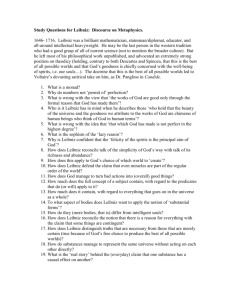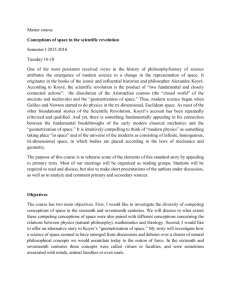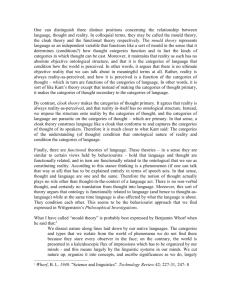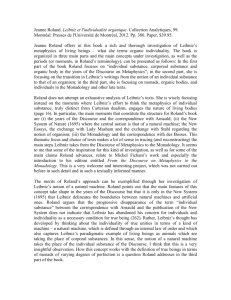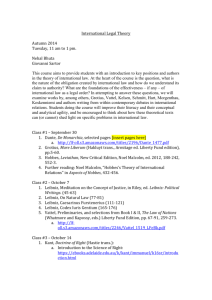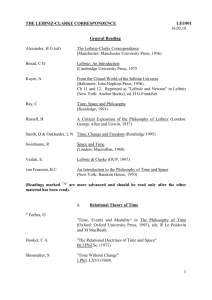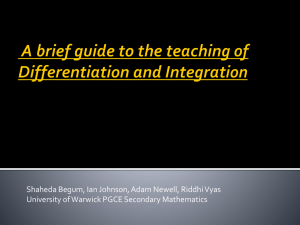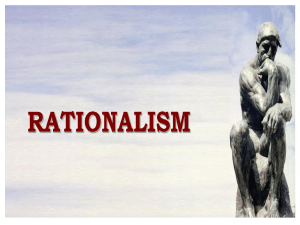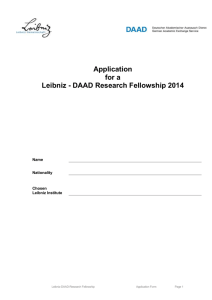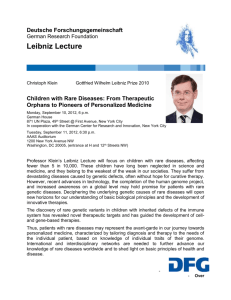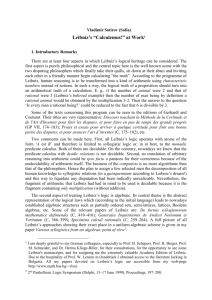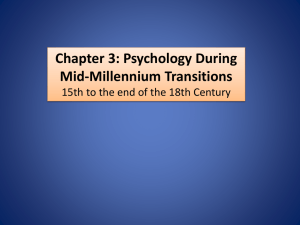F FORM 7 Evaluation of university study programmes of
advertisement
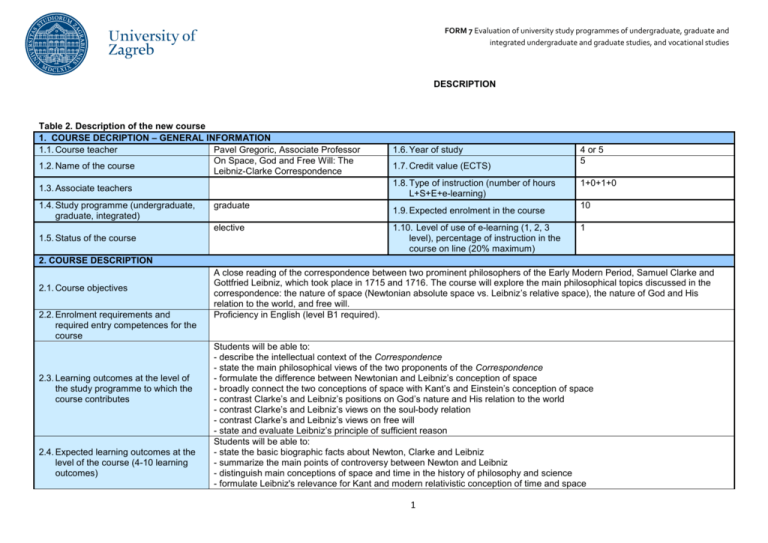
F FORM 7 Evaluation of university study programmes of undergraduate, graduate and integrated undergraduate and graduate studies, and vocational studies DESCRIPTION Table 2. Description of the new course 1. COURSE DECRIPTION – GENERAL INFORMATION 1.1. Course teacher Pavel Gregoric, Associate Professor On Space, God and Free Will: The 1.2. Name of the course Leibniz-Clarke Correspondence 1.6. Year of study 1.3. Associate teachers 1.8. Type of instruction (number of hours L+S+E+e-learning) 1.4. Study programme (undergraduate, graduate, integrated) graduate elective 1.5. Status of the course 1.7. Credit value (ECTS) 1.9. Expected enrolment in the course 1.10. Level of use of e-learning (1, 2, 3 level), percentage of instruction in the course on line (20% maximum) 4 or 5 5 1+0+1+0 10 1 2. COURSE DESCRIPTION 2.1. Course objectives 2.2. Enrolment requirements and required entry competences for the course 2.3. Learning outcomes at the level of the study programme to which the course contributes 2.4. Expected learning outcomes at the level of the course (4-10 learning outcomes) A close reading of the correspondence between two prominent philosophers of the Early Modern Period, Samuel Clarke and Gottfried Leibniz, which took place in 1715 and 1716. The course will explore the main philosophical topics discussed in the correspondence: the nature of space (Newtonian absolute space vs. Leibniz’s relative space), the nature of God and His relation to the world, and free will. Proficiency in English (level B1 required). Students will be able to: - describe the intellectual context of the Correspondence - state the main philosophical views of the two proponents of the Correspondence - formulate the difference between Newtonian and Leibniz’s conception of space - broadly connect the two conceptions of space with Kant’s and Einstein’s conception of space - contrast Clarke’s and Leibniz’s positions on God’s nature and His relation to the world - contrast Clarke’s and Leibniz’s views on the soul-body relation - contrast Clarke’s and Leibniz’s views on free will - state and evaluate Leibniz’s principle of sufficient reason Students will be able to: - state the basic biographic facts about Newton, Clarke and Leibniz - summarize the main points of controversy between Newton and Leibniz - distinguish main conceptions of space and time in the history of philosophy and science - formulate Leibniz's relevance for Kant and modern relativistic conception of time and space 1 F FORM 7 Evaluation of university study programmes of undergraduate, graduate and integrated undergraduate and graduate studies, and vocational studies DESCRIPTION 2.5. Course content broken down in detail by weekly class schedule (syllabus) 2.6. Type of instruction 2.8. Student responsibilities 2.9. Screening of student’s work (specify the proportion of ECTS credits for each activity so that the total number of CTS credits is equal to the credit value of the course)): 2.1. Grading and evaluation of student work over the course of instruction and at a final exam 2.2. Required literature (available at the - state Leibniz's principle of sufficient reason, principle of identity of indiscernibles, and pre-established harmony - sketch the main positions in the free will debate - indicate theological controversies in Early Modern Philosophy 1. Introduction 2. The context and the protagonists of the Correspondence 3. Newton on space, time, gravity and God 4. Leibniz's issues with Newton 5. Analyzing Leibniz's first and second letter and Clarke's replies 6. Religion, God and nature 7. Analyzing Leibniz's third letter and Clarke's reply 8. Space, time and God 9. Earlier conceptions of space and time, Kant and Einstein 10. Analyzing Leibniz's fourth letter and Clarke's reply 11. Extension of the soul and immortality 12. Free will: Clarke's libertarianism and Leibniz's compatibilism 13. Analyzing Leibniz's fifth letter and Clarke's reply 14. Matter, force and Leibniz's principles 15. Overview X lectures 2.7. Comments: X independent study X seminars and workshops multimedia and the internet Most course materials will be available X exercises laboratory in electronic format online in entirety work with the mentor mixed e-learning (other) field work Attendance, class discussion, one quiz, one essay, final written exam 0.5 Class attendance Research Practical training 0.5 1 Experimental work Report (summary) Discussion 1 0.5 Essay Seminar presentation Quiz Tests Oral exam (Other—describe) 2 Written exam Project (Other—describe) Sumary of argumentation 10% Discussion in class 20% Presentation 20% Quiz-test 10% Written exam 40% Title Number of Availability via 2 F FORM 7 Evaluation of university study programmes of undergraduate, graduate and integrated undergraduate and graduate studies, and vocational studies DESCRIPTION copies at the library library and via other media) H. G. Alexander, “Introduction”, in The Leibniz-Clarke Correspondence, Manchester, 1956, pp. ix-lvi R. Ariew, G.W. Leibniz and Samuel Clarke: Correspondence, Cambridge, 2000 I. Newton, Philosophical Writings, ed. A. Janiak, Cambridge, 2004 [parts] G. W. Leibniz, Philosophical Essays, ed. R. Ariew & D. Garber, Cambridge, 1989 [parts] 2.12. Optional literature (at the time of the submission of the study programme proposal) 2.13. Methods of monitoring quality that ensure acquisition of exit competences other media pdf pdf pdf pdf pdf pdf E. Vailati, Leibniz and Clarke. A Study of their Correspondence, Oxford, 1997. S. Clarke, A Demonstration of the Being and Attributes of God and Other Writings, ed. E. Vailati, Cambridge, 1998. G. W. Leibniz, Philosophical Papers and Letters, ed. Loemker, Dordrecht, 1989. I. Kant, Critique of the Pure Reason, tr. Kemp Smith, London, 1929. [“Transcendental Aesthetic”] F. Perkins, Leibniz: A Guide for the Perplexed, New York, 2007. N. Jolly (ed.), The Cambridge Companion to Leibniz, Cambridge, 1995. J. Ferguson, The Philosophy of Dr. Samuel Clarke and Its Critics, New York, 1974. L. A. Burtt, The Metaphysical Foundations of Modern Science, London, 1924, pp. 207-302. R. T. W. Arthur, “Space and Relativity in Newton and Leibniz”, British Journal for the History of Science 45 (1994), 220-240. C. D. Broad, “Leibniz's Last Controversy with the Newtonians”, in R. Woolhouse (ed.), Leibniz: Metaphysics and Philosophy of Science, Oxford, 1981, 157-174. R. Laymon, “Newton's Bucket Experiment”, Journal of the History of Philosophy 16 (1978), 399-413. A. Koyré A. and I. B. Cohen, “The Case of the Missing Tanquam: Leibniz, Newton & Clarke”, Isis 52 (1961), 555-566. S. Shapin, “Of Gods and Kings: Natural Philosophy and Politics in the Leibniz-Clarke Disputes”, Isis 72 (1981), 187-215. Student poll organised by the University 3
